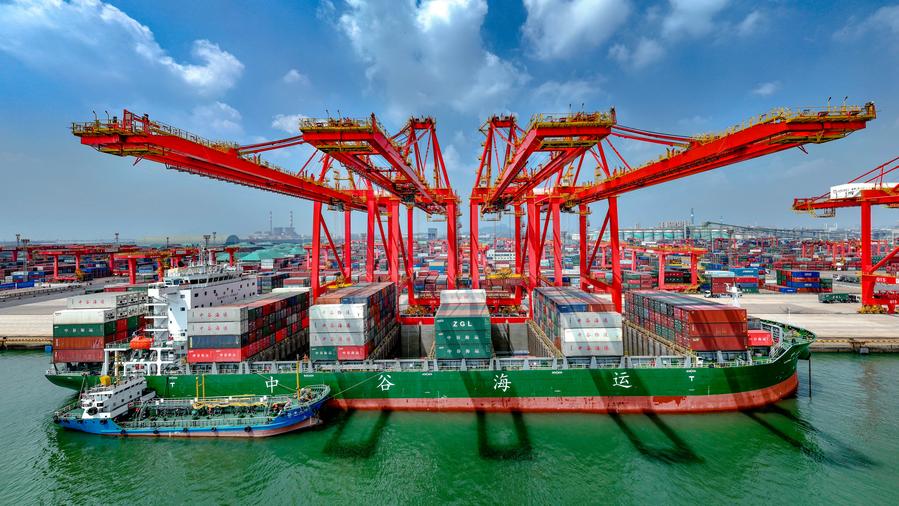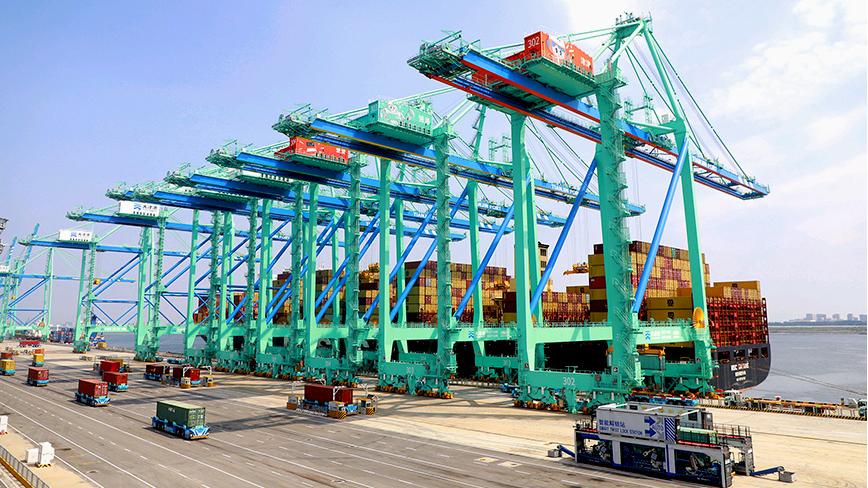Commentary: Why is the West peddling fear about China's manufacturing rise

A drone photo taken on Aug. 22, 2024 shows a view of the container terminal of Rizhao Port in Rizhao, east China's Shandong Province. (Xinhua/Guo Xulei)
Editor's note: "Dumping overcapacity on global markets," "the garbage time of history," "economic malaise making people fatter" ... A bunch of newly-coined concepts or unconventional observations regarding the world's second-largest economy have been spread widely, triggering fear, confusion and pessimism. Are they logically sound, well-founded and truly predictive of the future, or just over-exaggeration based on misperception or even deliberate talking-down out of deep-seated bias? This week Xinhua is releasing a series of three economic commentaries regarding this, and the following is the first piece.
BEIJING, Oct. 2 (Xinhua) -- It is no secret that global trade thrives on surpluses resulting from countries producing beyond domestic demand, and yet the term "overcapacity" has lately been conjured up as a nasty alternative to "surplus" to help fuel a narrative of fear spread by some in the West concerning China's manufacturing power.
This fear has been used to justify various protectionist actions, such as recent U.S. tariff hikes on some Chinese imports, Janet Yellen's G7 call to counter Chinese exports, and the European Commission's push for the disputed anti-subsidy probe into Chinese electric vehicles (EVs).
Portraying China's manufacturing capacity as a global risk, this narrative is a variant of the "China threat" rhetoric, with its toxic seed germinating in the hotbed of the West's anxiety, or probably fear, due to China's manufacturing rise.
From a low-cost manufacturing base to the world's largest manufacturing powerhouse and an up-and-coming leader in advanced industries and innovation, China's rapid elevation has unsettled some Western countries, who perceive it as an intolerable challenge to their industrial and trade dominance.
Responding to China's manufacturing prowess with such apprehension smacks of hypocrisy and also ignores basic economics. China's production capacity was seemingly not a problem at a time when many Western corporations capitalized on the country's low-cost original equipment manufacturer (OEM) production capabilities.
Neither was it a problem when Western superiority was underlined by China having to sell a billion pairs of socks to buy a Boeing airplane, nor when China's spare-parts production abilities helped propel worldwide sales of high-value-added products such as Apple iPhones.
Now, however, many in the West are viewing China's manufacturing engine with a critical eye -- particularly in the EV sector where Western dominance has largely been lost.
China's EV sector exported roughly 12.5 percent of its output last year. Viewing such a figure as a potential "supply shock" is clearly a fallacy and creates a strong suspicion of double standards on the part of the West. By this logic, the United States that sells around 80 percent of its chips overseas and Germany which exports about 80 percent of its cars, for instance, would be causing "supply earthquakes."
Reality is that China's EV sector offers not a shock, but rather an opportunity from which the world, including the West, can greatly benefit -- as it will be a huge boost for the global climate change battle.
At the core of the West's reaction is the desperation of politicians keen to shift public attention to an imaginary external enemy, in a bid to hide their incompetence in tackling thorny and deep-rooted domestic challenges.
These embattled politicians are also seeking to enlist allies in their attempt to mislead the world with a hypocritical narrative, which they hope will make it easier to justify both their tariff and non-tariff barriers. Here is a bitter lesson from the 1930s, when the United States enacted the Smoot-Hawley Tariff Act to protect its industries, but only to end up triggering a tariff war and dragging the world economy into an even deeper recession.
Such a ghost from the past could return to haunt us by deviating the current trajectory of global economic recovery, unless there is a serious reality check to clearly see what really benefits the world -- especially the vast majority of developing countries.
China is just one of many developing countries eager to achieve modernization and pursue technological upgrading. With some developing countries still in the nascent stages of industrial development, Chinese products and technologies are far from being threats, but vital catalysts for their consumption upgrades and industrial takeoffs.
There is no reason for the West to spread its anxiety to these countries, nor to pressure them into taking sides through diplomatic and economic coercion.
A closer bond never comes from a carrot-and-stick relationship, but instead flows from equal-footing trade driven by market demand and comparative advantages. By exporting the world's largest share of intermediate goods for 12 consecutive years, such as cells for the production of lithium batteries and tinned copper strips for photovoltaic panels, China has seen its production capacity closely integrated with the rest of the world, giving a meaningful boost to manufacturing in Southeast Asia, the Middle East, Latin America, and in particular Belt and Road participating countries.
Those hardwired to demonize China's manufacturing industry and amplify trade confrontation narratives have overlooked the crucial fact that China's manufacturing capacity has become an asset to global markets, as jobs have been added and technological transfer accelerated thanks to China's development.
Another calculation of Western fear-mongers might be the assumption that by manipulating global opinion, they can force China into changing its development course, or at least impede its robust growth in terms of innovation and economy.
However, China has every right to seek industrial advancement, which in fact is a basic strategy of the country as it pursues modernization through high-quality development.
Moreover, China's development is always rooted in pursuing what benefits the entire world. After making tenacious efforts to foster green production through open competition and long-term industrial planning, China has taken a leading role in developing decarbonization and green technologies, far outpacing the majority of the world in the process.
Since global supply of new energy products falls far short of the global demand required to meet climate response targets, China should hardly be expected to irresponsibly idle its green transition engine just to appease some Western critics.
Ironically, the West is actually more or less copying China's development strategy and industrial policies -- as reflected by the Inflation Reduction Act of the United States and the European Chips Act, though it remains in question just how effective their policies will be once the rubber actually meets the road.
A noteworthy hallmark of China's evolving industrial policies is their openness and practice of non-discrimination. Yet, some Western politicians with narrow geopolitical aims keep trumpeting "decoupling" and "de-risking," despite ample proof that no risks exist. When the 2024 version of the negative list for foreign investment access becomes effective on Nov. 1, China's manufacturing sector will be fully open to foreign investors.
This move could mean fiercer competition. But protectionism, a policy proven by history to be poison, has never been an option for China. If some in the West insist on leveraging fears to boost industrial and national fortunes, they may well find that they end up on the wrong side of history. Lessons from the past strongly suggest that encouraging open and fair competition is a wiser and more feasible option.
Photos
Related Stories
- China's manufacturing sector picks up pace amid sustained economic recovery
- 2,600 exhibitors participate in fair showcasing latest industrial development
- Number of China's manufacturing firms tops 6 mln
- Innovations at int'l manufacturing convention pave way for future industries
- China's manufacturing industry delivers new momentum
- 2024 World Manufacturing Convention held in Hefei
- Convention in east China highlights smart manufacturing
Copyright © 2024 People's Daily Online. All Rights Reserved.









